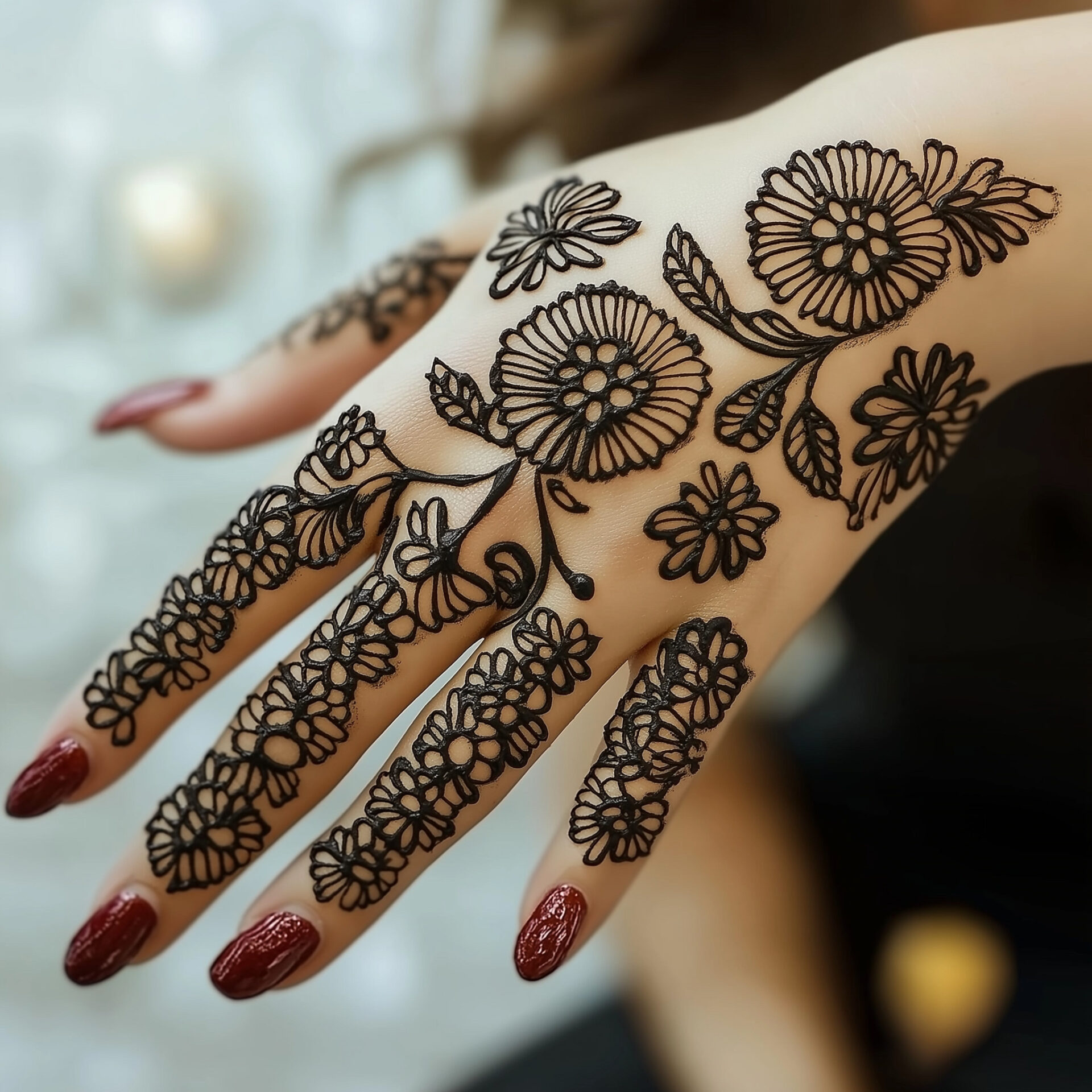Indian Mehndi Designs on the Back Hand: A Dialogue Between Art and Culture
In the world of art, the human hand has always served as a profound canvas. Whether it’s through the precise lines of a sculptor’s chisel or the flowing patterns of Mehndi, there’s a transformative power in how we decorate and shape our bodies. Indian Mehndi designs, particularly those adorning the back of the hand, offer a striking example of this interplay between form and expression. They’re more than just decorations – they are a living dialogue between tradition, artistry, and personal meaning.
As someone who has spent years working with materials, shapes, and spaces, I find the artistry behind Indian Mehndi deeply resonant. The back hand, with its unique balance of negative space and intricate design, offers an opportunity for expression that moves with the body. The way these designs complement the natural curves of the hand, creating visual harmony, reminds me of how sculpture interacts with light and shadow, constantly shifting as the viewer moves around it.
The Back Hand as a Canvas for Personal and Cultural Expression
Indian Mehndi designs on the back hand often present a delicate balance between bold motifs and open spaces, allowing the skin to breathe while still embracing complexity. This duality is much like the contrast I often seek in my own work – the tension between form and emptiness. The hand, in this case, becomes an extension of the art itself, with the Mehndi not merely decorating but accentuating the inherent beauty of the body.
In Indian tradition, the back hand is often adorned with symbols that hold cultural and spiritual significance. Lotus flowers, paisleys, and geometric patterns frequently appear, each carrying layers of meaning. The lotus, for instance, represents purity and resilience – a flower that rises from the mud but blooms with grace. The way these motifs spread across the hand mirrors the unfolding of personal and collective stories, much like how art reflects life’s journey.
What fascinates me about the Indian back hand Mehndi designs is how they manage to blend form and meaning so effortlessly. Each line is drawn with intention, much like how a sculptor shapes stone with purpose. The swirling vines and delicate petals that stretch from the fingertips to the wrist speak to the fluidity of life, while the more structured patterns anchor the design in tradition. There’s a rhythm to it – one that feels both ancient and deeply personal.

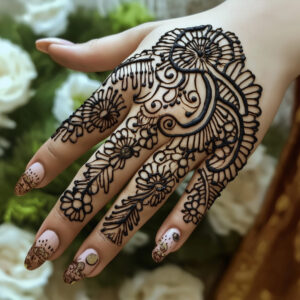
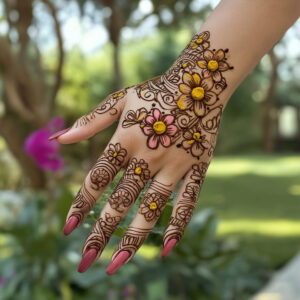


The Art of Negative Space and Detail
What makes Indian Mehndi on the back hand particularly captivating is its use of negative space. Unlike the more densely packed designs often found on the palms, the back hand allows for more breathing room, with intricate lines woven into the natural contours of the hand. This approach reminds me of how sculptors carefully carve away material to reveal the essence of their work. In Mehndi, the skin itself becomes part of the design, with the empty spaces playing just as important a role as the drawn lines.
The placement of designs on the back of the hand is often strategic, with artists using the natural structure of the hand to guide the flow of the Mehndi. Fingers are adorned with geometric shapes, sometimes creating a lattice effect, while the center of the hand might feature a single floral motif or mandala. This interplay between simplicity and complexity gives the design a dynamic quality – one that changes with every movement of the hand.
It’s this dynamic relationship between stillness and motion that draws me to Mehndi as an art form. Much like a sculpture that invites you to walk around it, Mehndi invites both the wearer and the observer to engage with the design in new ways as the hand moves. The design isn’t static; it lives and breathes with the person who wears it.
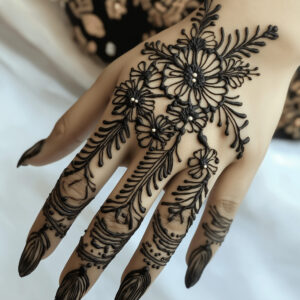

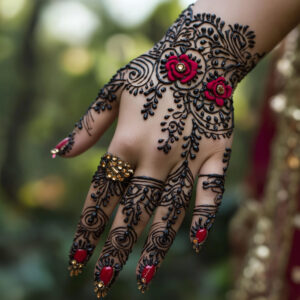
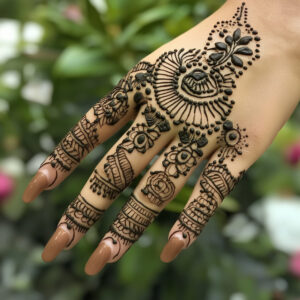
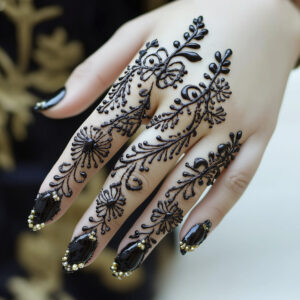
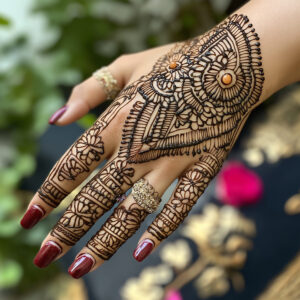
A Cultural Art Form That Transcends Time
What strikes me most about Indian Mehndi designs, particularly on the back hand, is how they transcend time. These designs, passed down through generations, continue to evolve while staying true to their roots. For many, Mehndi is part of the rituals surrounding weddings, festivals, and family gatherings – but it’s also a personal expression of identity.
Much like my own work in sculpture, where I strive to bridge the gap between the traditional and the modern, Mehndi reflects a similar dialogue. While the designs themselves may be rooted in cultural history, they are constantly being reinterpreted by the individuals who wear them. Each artist brings their own perspective, much like how a sculptor adds their unique touch to a piece. In this way, Mehndi is both timeless and ever-changing – an art form that evolves with the person who wears it.
In observing the Mehndi designs applied at Indian weddings and festivals, I see how they serve as a connection between the past and the present. The designs on the back hand are often more subtle than those on the palm, but they carry just as much significance. They are a reminder that art is not just about what we see but about how it makes us feel, how it connects us to something greater.
Conclusion: Mehndi as Living Art
In the end, Indian Mehndi designs on the back hand are more than just a visual experience – they are a form of living art. They move with the body, they shift with the light, and they carry stories both personal and cultural. Much like how sculpture transforms space, Mehndi transforms the hand, turning it into a canvas that tells a story with every line and curve.
For me, Mehndi represents the perfect intersection of art and life. It’s a reminder that beauty doesn’t just exist in galleries or museums – it’s in the everyday moments, in the way we choose to express ourselves and connect with our heritage. And as these designs fade with time, they leave behind memories, much like how a sculpture might erode but never truly lose its form.
Keep Exploring Mehndi Art:
- Arabic mehndi design front hand – Dive into the elegance of Arabic Mehndi on the front hand, where bold lines and delicate details come together to create stunning visual art.
- Arabic Mehndi designs right hand – Discover how Arabic Mehndi transforms the right hand into a flowing work of art, with intricate patterns that shift and change with every movement.
